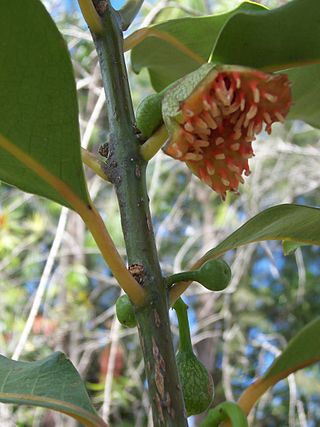
The Monimiaceae is a family of flowering plants in the magnoliid order Laurales. It is closely related to the families Hernandiaceae and Lauraceae. It consists of shrubs, small trees, and a few lianas of the tropics and subtropics, mostly in the southern hemisphere. The largest center of diversity is New Guinea, with about 75 species. Lesser centres of diversity are Madagascar, Australia, and the neotropics. Africa has one species, Xymalos monospora, as does Southern Chile. Several species are distributed through Malesia and the southwest Pacific.

Peter Hamilton Raven is an American botanist and environmentalist, notable as the longtime director, now President Emeritus, of the Missouri Botanical Garden.

Hibbertia, commonly known as guinea flowers, is a genus of flowering plants in the family Dilleniaceae. They are usually shrubs with simple leaves and usually yellow flowers with five sepals and five petals. There are about 400 species, most of which occur in Australia but a few species occur in New Guinea, New Caledonia, Fiji and Madagascar.

Baeckea is a genus of flowering plants in the myrtle family, Myrtaceae, all but one endemic to Australia. Plants in the genus Baeckea are shrubs or small trees with leaves arranged in opposite pairs, white to deep pink flowers with five sepals and five petals, and five to fifteen stamens that are shorter than the petals.
Lilian Suzette Gibbs (1870–1925) was a British botanist who worked for the British Museum in London and an authority on mountain ecosystems.

Matthew Hilary Peter Jebb is an Irish botanist and taxonomist specialising in the ant plant genera Squamellaria, Myrmecodia, Hydnophytum, Myrmephytum and Anthorrhiza, as well as the carnivorous plant genus Nepenthes.

Daphniphyllum is the sole genus in the flowering plant family Daphniphyllaceae and was described as a genus in 1826. The genus includes evergreen shrubs and trees mainly native to east and southeast Asia, but also found in the Indian Subcontinent and New Guinea.

Lechenaultia is a genus of flowering plants in the family Goodeniaceae, the species native to Australia with one species also occurring in New Guinea. Plants in the genus Lechenaultia are glabrous shrubs or herbs with needle-shaped leaves, more or less sessile flowers with five sepals and five blue, white, or yellow and red petals in two unequal lobes, the fruit an elongated capsule.

Helmholtzia is a small genus of flowering plants described in 1866. It includes species native to Australia, Indonesia, and New Guinea.
Thomas Gordon Hartley was an American botanist.
Apotreubia is a genus of liverworts in the family Treubiaceae. There are four species, including: Apotreubia nana, which is found in subalpine New Guinea, and Apotreubia pusilla, which has a disjunct distribution between eastern Asia and British Columbia.

Georg Ludwig August Volkens was a German botanist born in Berlin.
Maoutia is a genus of shrubs or small trees in the nettle family (Urticaceae).
Daniel Howard Norris was an American botanist dedicated to the study of mosses, and was a renowned expert on the California bryoflora. The standard author abbreviation D.H.Norris is used to indicate this person as the author when citing a botanical name.

Calyptrocalyx hollrungii is a palm species in the family Arecaceae, and is native to Papua New Guinea and to the Indonesian part of New Guinea, Western New Guinea.
Pieter van Royen (1923-2002) was a Dutch botanist. He is an author of many papers on the flora of New Guinea.
Pullenia gunnii is a species of flowering plant in the legume family, Fabaceae. It is the sole species in genus Pullenia.
Merrilliobryum tanianum is a species of moss in the family Myriniaceae. It is endemic to the Huon Peninsula of New Guinea.
Henricus (Harrie) Johannes Maria Sipman is a retired Dutch lichenologist who specialised in tropical and subtropical lichens and authored or co-authored over 250 scientific publications. He was the curator of the lichen herbarium at the Berlin Botanical Garden and Botanical Museum from 1983 until his retirement in 2010. Between 1990 and 1997 he edited and distributed the exsiccata Lichenotheca Latinoamericana a museo botanico Berolinensi edita.
Semecarpus magnificus is a species of plant in the family Anacardiaceae. It is endemic to New Guinea.









